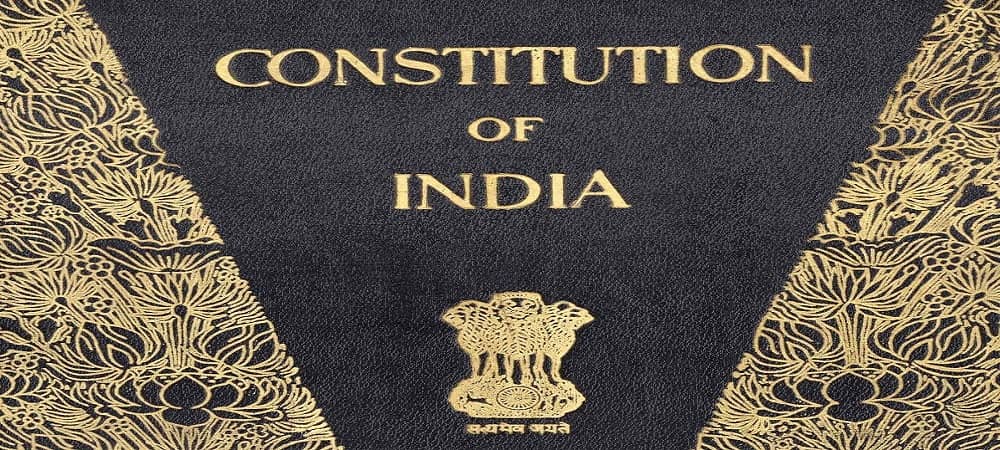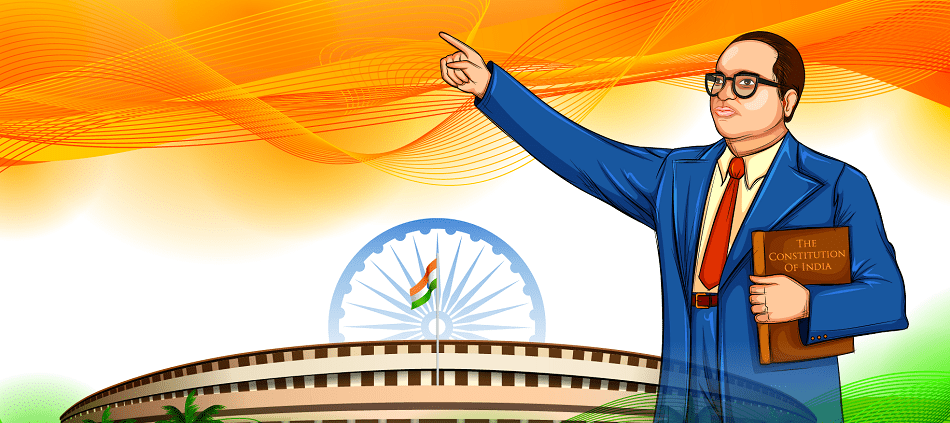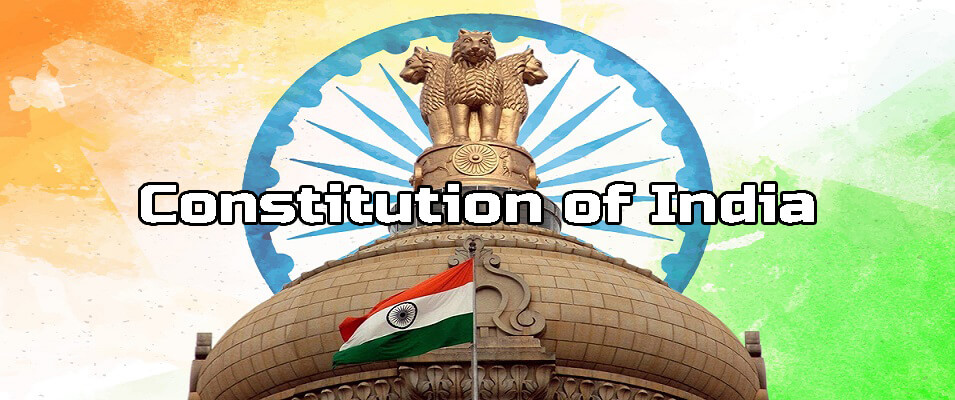As we all know, our country is a democratic State, the reason behind India being a Democratic State is the Constitution of India. As a citizen of India, one must be aware of the Constitution of India, what it says and what its features are? To know about this here is an Essay on Constitution of India.
What is the meaning of the Constitution?
A constitution is a supreme law of the country which means that there is no law above it. It lays on the framework which assesses the people of a territory to realize the national goals and ideals. It also lays down a framework for the political system under which the people of the country are governed.
It establishes the relationship among its citizens as well as the relationship between the Government and its people by determining the rights of the people, the powers and the functions of the government which is accepted by all people of a country.
All countries that have a Constitution are not necessarily Democratic such as China. But all Democratic Countries compulsorily have a constitution whether it is in written form or not. For instance, Britain does not have a written constitution however it has a well-established constitutional procedure to determine its government system whereas the USA & India have a written constitution to determine the same.
History of Constitution of India
A Constituent Assembly was set up in the year 1946 to make the Constitution. The first meeting of the Constituent Assembly was held on 9th December 1946. Dr. Sachchidanand Sinha was appointed as the temporary President of the Constituent Assembly. Then on the basis of Election, Dr. Rajendra Prasad was appointed as the President of the Constituent Assembly. HC Mukerjee & VT Krishnamachari were later elected as the Vice President of the Constituent Assembly.

On 13 December 1946, Jawaharlal Nehru presented the ‘Objective Resolution’ in the Assembly. Objective Resolution consisted of principles of the Constitution, which later became the Preamble. The Objective Resolution was unanimously adopted by the Constituent Assembly on 22 January 1947. On 29 August 1947, the drafting Committee appointed Dr. B.R. Ambedkar as the Chairman of the Constituent Assembly. He is also known as the ‘Chief Architect of the Indian Constitution’.
Why do we need a constitution?
It creates trust and coordination among the people of a country providing the productivity and reliability of their actions and it also specifies how people are going to be governed and lays down specific guidelines for the decision-making process of the Government.
It also sets a limit to the powers of the Government by describing the rights of the Citizens and specifying the powers and responsibilities of the Government. It provides a set of basic rules that allow minimal coordination amongst the members of a Society. Basically, the Constitution expresses the aspirations of the people and helps in creating a good society.
Structure of Constitution of India:-
- 470 articles
- 25 parts
- 12 schedules
- 5 appendices
Features of the Constitution of India:-
- Preamble- It is basically an introduction or the preface to the Constitution and it summarizes the Constitution in one sheet. It is based on the Objective Resolution that was drafted and moved by Dr. Jawaharlal Nehru and adopted by the Constituent Assembly. The first line of the Preamble starts with “WE, THE PEOPLE OF INDIA”.
- Fundamental Rights- Part III of the Constitution consists of Fundamental Rights which are guaranteed to all citizens of India. These rights are meant for promoting political democracy and set limitations on the Executive and Arbitrary laws of the legislature. These are justiciable in nature which means that the agreed person can go the Supreme Court in order to restore his/her rights. Thus, they act as a negative obligation on the state. However, these rights are not absolute and are subject to reasonable restrictions. Fundamental rights are essential for the all-round development of the country as they uphold the equality and dignity of the larger public interest and the unity of the nation.
Fundamental Rights-
- Right To Equality
- Right To Freedom
- Right Against Exploitation
- Right To Freedom Of Religion
- Cultural And Educational Rights
- Right To Constitutional Remedies

- Directive Principle of state policy- It is a feature incorporated in part IV of the Indian Constitution. It is meant for promoting social and economic democracy. These principles seek to establish a welfare state in India. It acts as a positive obligation on the State where the State has powers to do certain things in order to implement these principles. Unlike the Fundamental Rights, they are not justiciable and non-enforceable by the Court of Law.
- Single Citizenship- Unlike the USA which provides for US citizenship by the National Government as well as State Citizenship by the respective State Government, India provides only for a Single Citizenship i.e. the Indian Citizenship provided by the National Government only. To get Indian Citizenship, one must reside in India for at least 5 years.
- Fundamental Duties- Fundamental Duties were added by the 42nd Amendment act.1976 and were recommended by Swaran Singh Committee. They serve as a reminder to the Citizens that while enjoying Rights, they have to be conscious about duties that they owe to their Country, their Society, and Citizens. However, like the Directive Principle of State Policies, Fundamental Duties are also non-justiciable.
Fundamental Duties-
- Abide By Constitution
- Protect Natural Environment
- Preserve Rich Heritage
- Defend Country
- Safeguard Property
- Promote Harmony
- Parliamentary System– The Constitution provides for a parliamentary form of Government in which the Prime Minister and other Ministers are selected from the Legislature. This system establishes the collective responsibility of the Executive to the Legislatures.
- Independent Judiciary- The Constitution establishes a Judicial System that is integrated as well as independent. In this system, the Supreme Court is on top in this integrated hierarchy. After the Supreme Court, there are High Courts at State levels. Under the High Court, there is a well-organized hierarchy that consists of District Courts & Lower Courts.
- The balance between Parliamentary Sovereignty & Judicial Supremacy – The Constitution provides for a balance between Parliamentary Sovereignty & Judicial Supremacy. The Supreme Court through its power of Judicial Review can declare the Law passed by Parliament as Unconstitutional whereas the Parliament can amend major portions of the Constitution with a special majority by both houses i.e. Lok Sabha & Rajya Sabha of Indian Parliament.
- Blend of Rigidity and Flexibility- The Constitution of India is a blend of rigidity and flexibility. The Constitution of India is neither rigid like the US Constitution nor flexible like the British Constitution. Instead, it is a synthesis of both, Rigid as well as flexible at the same time. Article 368 provides for various types of amendments depending on the situation. At the same time, the basic structure doctrine does not allow the Court Principles of the Constitution to be amended. All amendments to the Constitution are initiated only in the Parliament.
- Federal System with Unitary Bias- India provides for a Federal System of Government because it provides for two Governments i.e. the Centre and the State Government.
Features of Federalism-
- Two Governments
- Division of Powers
- Supremacy of Constitution
- Independent Judiciary
- Bicameralism
- Rigidity of Constitution
- Written Constitution
Unitary features:-
- Strong Centre
- Single Constitution
- Single Citizenship
- Flexibility Of The Constitution
- Integrated Judiciary
- Appointment Of The State Governor By The Centre
- All India Services
- Emergency Provisions
- People as Source of Authority- The Constitution clause its authority from the people and has been propagated in the name of the people. For instance, in the preamble ‘we the people of India’ tells us Sovereignty lies with the people of the Country.
- Universal Adult Franchise- The Constitution presents the right to equal vote for all adult citizens of above 18 years which is very essential for any Democratic Country. This ensures equal participation of all citizens in the democratic process of the Country. It also gives a sense of dignity and empowerment to the poor, minorities, and other backward classes as they have an equal say in the matters of their Country.
- Secular State- India’s Secularism is unique because it has no official religion but not completely disconnected to the matters of religion, especially when it demands reforms. For instance, the abolishment of Triple Talaq and allowing the entry of women into Sabrimala Temple, etc.
- Bicameralism- The Constitution provides for voters, the Bicameral Legislature; which means that the Parliament consists of two houses i.e. the House of the People (Lok Sabha) & the Council of States (Rajya Sabha). At the State level, it provides for a Legislative Assembly and Legislative Council if it is needed. The Members of Lok Sabha are ire of the people and are directly elected by the people. Members of Rajya Sabha are elected by the members of all State Legislative Assembly by proportional representation.
- Emergency Provisions- The Constitution contains emergency provisions to enable the President of India to deal with extraordinary situations such as external aggression, failure of constitutional machinery in states, and Financial Emergency. Part 18 of the Indian Constitution contains emergency provisions. Article 352 deals with National Emergency, Article 356 deals with State Emergency whereas Article 360 describes Financial Emergency. Only the President of India has the authority and power to declare an Emergency.
- Special Provision for Minority- The Constitution has specified provisions for both religious and linguistic minorities to protect their interests. Due to these provisions in the Indian Constitution, no community of minorities gets left behind.
- 3 tier Government System- The Government is categorized as Central Government, State Government, and Local Government. The local Government is further categorized into Panchayati Raj Institutions and Municipal Corporations as per the amendment 73rd and 74th respectively to enhance grass root Democracy through which people can directly take part in the decision making process. This is how democracy prevails in all levels of the Government in India.
- Independent Bodies- The Constitution not only provides for Legislative, Executive & Judicial organs but also establishes Independent bodies such as Election Commissions, C.A.G, U.P.S.C, and State P.S.C, etc. for ease of administration. These independent bodies help with the working of the Government.
Also Read Top 16 key features of Indian Constitution, Supreme law
Criticism of the Indian Constitution
The Indian Constitution is known to be the lengthiest Constitution of the World and it is bulky and too detailed containing some unnecessary elements. The Constitution is also too legalistic making it a complex document for it to be interpreted by ordinary people as well as the Lawmakers.
It is called the Lawyers’ paradise because it opens vast avenues of litigation, giving lawyers a lot of work. The Indian Constitution does not contain the philosophy & ideals of Mahatma Gandhi, the Father of the Nation. Critics have opined that the Constitution should have been built upon the village and district panchayats system.
Despite its criticism, the people of India have happily accepted the Constitution because the Constitution did not merely contain the views of the constitution-makers but also that of several large social & political parties. In other countries such as Nepal, where the Constitution was failed because the large social groups did not accept the Constitution.
Another reason why the Constitution was accepted by the people of India is because of the diverse representation at the Constituent Assembly. Although the members of the Constituent Assembly were mainly elected by the provincial Legislative Assembly, They ensured that the fair share of members from all regions of the country was represented. If there had been an election involving the masses of a similar set of members then they would have been elected.
Conclusion-
The Constitution does not only contain rules and regulations controlling the powers of the Government. It also gives power to the Government for pursuing the collective good of the Society.
The Indian Constitution is a unique document which in turn became an example for many other Constitutions. For example- South Africa. The Constitution of India was originally written in Hindi, later it was written in English. It was handwritten by Prem Behari Narain Raizada. The original copies of the Constitution are stored in a special case. This most complexly produced document has not only survived but has also become a living reality due to the wisdom and foresight of the makers of the Constitution.
